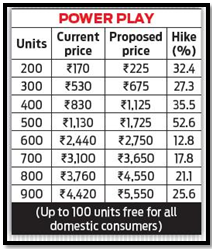IMPACT AND CONTROVERSIES SURROUNDING THE RECENT ELECTRICITY TARIFF HIKE IN TAMIL NADU
Syllabus:
- GS-3- Electricity hike, infrastructure , Social and physical development
Focus :
- The article discusses the recent electricity tariff hike in Tamil Nadu, its impact on various sectors, especially Micro, Small, and Medium Enterprises (MSMEs), and the controversies surrounding the Tamil Nadu Generation and Distribution Corporation Limited (TANGEDCO). It also explores the reasons behind the tariff hike and the state’s measures to address the power utility’s financial challenges.
Source - IE
Introduction
- Effectiveness: The hike was made effective retrospectively from July 1.
- Announcement: On July 15, the Tamil Nadu Electricity Regulatory Commission (TNERC) announced an average 4.07% increase in electricity tariffs for domestic and other consumers
- Timing: The Commission delayed the announcement until after the Lok Sabha and Vikkramandi Assembly by-election results.
- Annual Revision: TNERC indicated in a 2022 order that the tariff would be revised annually from July.
Reasons for the Tariff Hike
- Three-Year Tariff Framework: The current revision is part of a three-year tariff framework starting from FY2022-23 to FY2026-27.
- Consumer Price Index (CPI): The CPI, which increased by 49.96% between 2018 and 2022, was used to justify the hike.
- Inflation Adjustment: The Commission decided that tariff increases should reflect inflation trends.
- State Support: Tamil Nadu has been supporting TANGEDCO with financial assistance due to its losses.
Impact on Consumers
- Domestic Consumers: There is no change in the free consumption scheme of 100 units per month for domestic consumers.
- Burden on MSMEs: MSMEs, which number over 25 lakh, have protested against the hike due to the increased financial burden.
- Industry Impact: Higher electricity charges could make Tamil Nadu’s industries less competitive.
- Annual Revenue: The increase is expected to generate an additional revenue of ₹12,720 crore for TANGEDCO.
Protests by MSMEs
- Cost of Production: MSMEs argue that the tariff hike will significantly increase their cost of production.
- Employment: The sector provides substantial employment and fears job losses due to increased operational costs.
- Specific Industries: Spinning mills and other industries have highlighted the specific additional charges they will incur.
- Previous Increases: MSMEs are already burdened by frequent tariff increases and additional demand charges from the previous year.
TANGEDCO’s Financial Challenges
- State Support: TANGEDCO has been receiving significant financial support from the state government.
- Tariff Subsidies: The state has absorbed the burden of tariff increases for many consumers.
- Fiscal Burden: The fiscal burden on the state due to TANGEDCO’s losses and subsidies is substantial.
- Revenue Projections: Despite the tariff hike, TANGEDCO is expected to end the year with a deficit due to increasing demand.
Controversies Surrounding TANGEDCO
- Vigilance Inquiry: The Directorate of Vigilance and Anti-Corruption (DVAC) registered a preliminary inquiry into allegations of irregularities in coal procurement.
- Allegations: Allegations involve massive corruption in the import of coal between 2012 and 2016, causing substantial losses to the state.
- Involved Parties: The inquiry implicates TANGEDCO officials and several private entities, including Adani Global Private Limited.
- Quality Concerns: There were allegations regarding both the cost and quality of the coal supplied.
Measures to Improve Power Supply
- Quality Control: The state government has formed a wing headed by a Superintending Engineer to oversee the quality of domestic and imported coal.
- Sampling and Analysis: The Quality Control Wing, along with the Central Power Research Institute (CPRI), is engaged in sampling and analyzing coal.
- Improving Infrastructure: Upgrading infrastructure and ensuring efficient distribution to minimize losses.
- Policy Statements: The state’s power policy for 2024-25 outlines measures to improve power supply and reduce fiscal losses.
Political Reactions
- Opposition Protests: Many political parties have condemned the tariff increase, arguing it burdens the common man and businesses.
- Government Stance: The state government has maintained that the hike was necessary to support TANGEDCO and improve financial stability.
- Public Sentiment: There is a mixed reaction among the public, with concerns over increased living costs.
- Future Tariffs: Speculation continues about future tariff adjustments and the government’s long-term strategy.
Conclusion
- Balancing Act: The Tamil Nadu government faces a challenging task of balancing the financial health of TANGEDCO and addressing the concerns of consumers and industries.
- Sustainability: Sustainable financial practices and transparency in operations are crucial for long-term stability.
- Consumer Protection: Ensuring minimal impact on consumers, especially vulnerable groups, is essential.
- Future Prospects: Continued monitoring and adjustments will be necessary to align with economic conditions and consumer needs.
Mains UPSC Question
Discuss the recent electricity tariff hike in Tamil Nadu and its impact on different sectors, especially MSMEs. What are the underlying reasons for the hike, and how has the Tamil Nadu Generation and Distribution Corporation Limited (TANGEDCO) been involved in controversies recently.” (250 words)
Source:The Hindu




